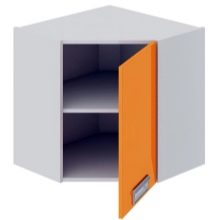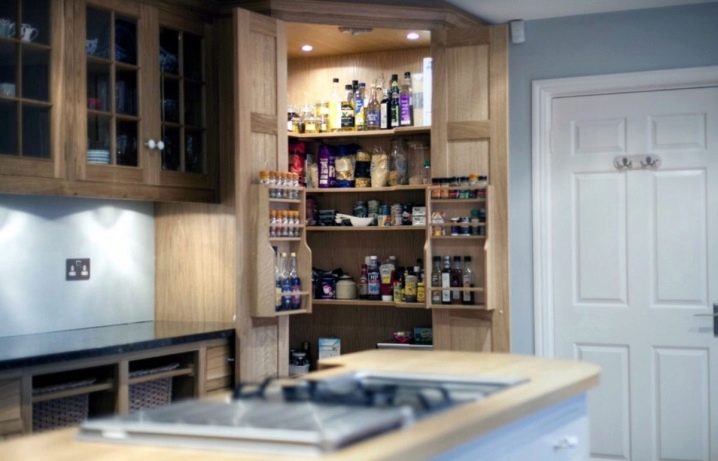Corner wall cabinets for the kitchen: features and types

The corner wall cabinet is a low pedestal, which is the connecting part of the two hanging halves of the headset. From the point of view of economy and convenience, it is more advisable to purchase a corner cabinet than two rectangular cabinets, then puzzling over how to connect them together. Consider what types of cabinets exist, how the shelves are convenient and whether there are any disadvantages, as well as how to choose the right corner cabinet and attach it.

Varieties
There are three main types of mounted models: butt, L-shaped and trapezoidal.
- Butt, in turn, has the shape of a rectangle. This form is ideally combined with a sink, but the disadvantage will be inaccessibility to the butt wall.
- L-shaped - the shape of the corner, repeating the corner of the wall. It is considered a more popular option, the disadvantage is the small capacity (small internal volume).
- Trapezoidal - has a beveled corner. A common option for large kitchens, since this type is quite large.



Hanging cabinets are distinguished by their functional purpose:
- storage of food and kitchen utensils;
- storage and drying of dishes;
- installation of the hood.


Some models serve as decorative items. They can accommodate various little things and decor items. The inner content can be completely different. Filling the structure is possible with various types of shelves, drawers or even baskets. It can even be combined by dividing the top corner cabinet in half both vertically and horizontally. If you divided horizontally, then one of the parts can be made open or with a mirrored door, everything will depend on the chosen style.


Shelf or cabinet?
The corner part can be either a closed cabinet with doors, or an open cabinet without doors in the form of ordinary shelves. They do not take up much space and are easy to install (using hinges, corners or brackets). One of the cheaper options does not require heavy assembly. Despite its pros, there are also downsides. Standing kitchen utensils are not dustproof and require frequent cleaning. Therefore, it is more advisable to install kitchen cabinets.


Different types of door opening systems are possible:
- standard type of opening is the most common and convenient, easy to strengthen and replace;
- compartment doors, a compact option for use, but when one side is opened, they close access to the other;
- "Book" or "accordion" - small-sized, there is access to all content, but they are short-lived.


Materials (edit)
Consider what material to choose for a corner wall cabinet. Before making your choice, you need to think over the location of both shelves and household appliances. Decide on the size, choice of material and facade. Kitchen furniture is made of the following materials: MDF, laminated chipboard (laminated particle board) and plastic. First, MDF must be carefully primed, then apply several layers of paint, let it dry, then cover with a layer of varnish to fix it.

The advantage of the material is affordability, resistance to water and high temperatures, obtaining any color of paints from matte to bright palettes. Weak points include loss of brightness and color saturation under the influence of ultraviolet rays, susceptibility to surface damage. Chipboard can be considered no less affordable.A temporary option for use is chipboard, one of the most budgetary materials, and this is the only positive point. It has many disadvantages: it is prone to scratches, due to its low resistance to moisture, the material quickly exfoliates, deforms and breaks down.

The third most popular material is plastic. It can be divided into two production technologies: MDF + plastic, chipboard + plastic. As previously noted, MDF facades will be more expensive, and MDF + plastic will also be more expensive. The advantage is a huge selection of colors, resistance to high temperatures, moisture and odors, long service life. This material is still imperfect and also has minor, but still disadvantages: fingerprints remain on the surface, limited manufacturing capabilities - only the evenness of the surface is inherent.

One of the options is to be made from natural wood. As already clear, the option is not cheap. Depending on the type of natural wood, mahogany, oak, ash, walnut, fir, alder, beech, birch and its subspecies hornbeam, others are used. The finishing board can be treated with oil, varnish or wax to add richness and naturalness to the color, as well as protect against deep scratches. Such protection will prevent the occurrence of harmful insects (shashel) and extend the operational life of the furniture structure being manufactured.

When choosing a material, you need to take into account the amount you are counting on, and already build on this. The next step is to decide on the style, measure and plan everything down to the smallest detail.
Design options
With regard to design and decoration, it is worth highlighting a number of current styles.
- Provence. Furniture should be light and light in color, while combining convenience with sophistication and compact placement. Often, a wooden headset is combined with metal or glass inserts. Provence is known as a warm and cozy style.
- Classical - naturalness is characteristic. The current choice of colors from light beige to dark brown palettes. This style is characterized by restraint and rationality of use.


- Country - similar to the classic style. Imitation of artificially aged furniture is preferable; inserts or handles made of yellow metal are used for contrast. This style is used in large rooms.
- Modern. A characteristic feature is smoothness, curvature of forms and asymmetry of lines. The distinctive features of the style include corner oval niches for installing household appliances and recessed doors. Saving space is also characteristic of Art Nouveau. Nothing superfluous, the appliances should be built into the design of kitchen furniture, the colors should be calm and soft, as if dimmed.


- High tech - ideal for small kitchens. Assumes the use of metal and glass inserts. Everything should be perfectly even, observing all proportions. Ideal for use in corner cabinet designs.
- Minimalism - he says about himself. Correctness of forms, absence of unnecessary details. There should be plenty of work space and light. Gloss is used as a material - that is, a mirror surface.


- Art deco - differs in high cost, as the furniture is made of natural wood with the use of precious stones, marble, leather and other expensive materials. Usually rich shades are used: from velvety to purple. Durability and functionality covers the high cost.
- Ethno - there are Japanese, Italian, Scandinavian designs. Each of them has its own color palette (Japanese - dark, Scandinavian - light tones), displaying the culture of local residents.
- Eclecticism - loves a lot of decorated elements, is full of a variety of colors, resorts to using several styles. Characteristic are plastic shapes, softness and comfort.


How to attach?
Installation is considered an important process after choosing and purchasing a locker. The structure must be securely fastened, as it will be filled with dishes or other kitchen utensils. There is a huge selection of fastening elements:
- if the wall is wooden, use screws with a countersunk semicircular head or two-start thread;
- brick or concrete - dowels, anchors-bolts;
- gypsum plasterboard - plastic or metal screwed dowels.

The preparation of the walls is necessary before fixing a particular structure. Make sure that they are even, in the given place where the hole will be drilled, there should be no wires connected to electricity.
Generally established two mounting options.
- A common type of suspension is mounting on a DIN rail or rail. For uniform suspension, two slats are used at the top and bottom. The mount evenly distributes and withstands even the heaviest loads. For fixing to the wall, dowels with self-tapping screws are used, suspended on special loops.
- Fasteners using hinges are no less popular. This is a unique furniture fixture, but it takes a lot of time and there is a need for help. The mount is quite inexpensive, unlike the previous version, but it has a significant drawback - the attached cabinet is not adjustable.

For information on how to attach a corner wall cabinet to the kitchen, see the next video.













The comment was sent successfully.